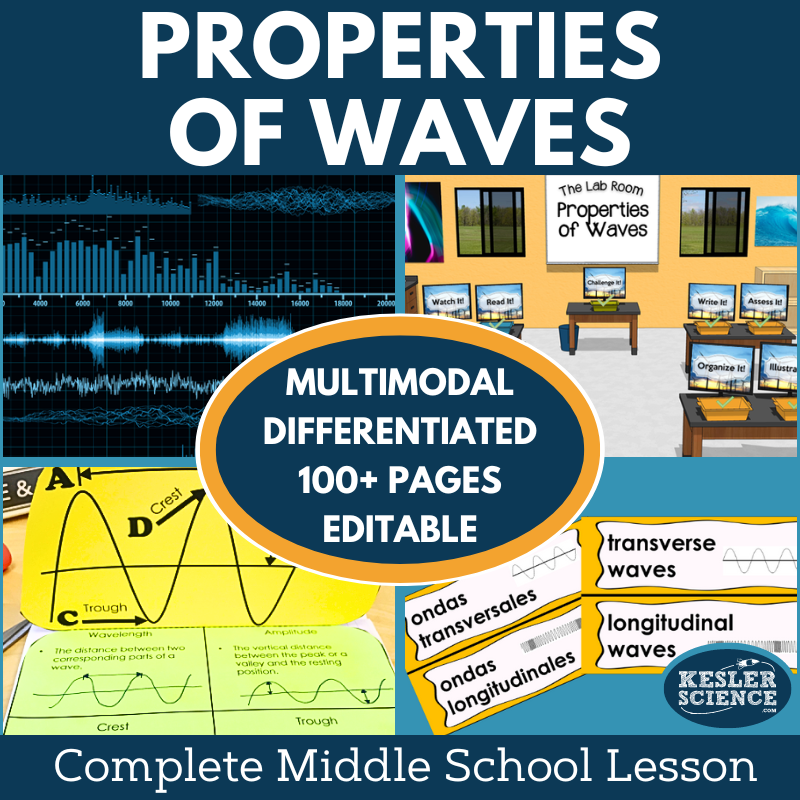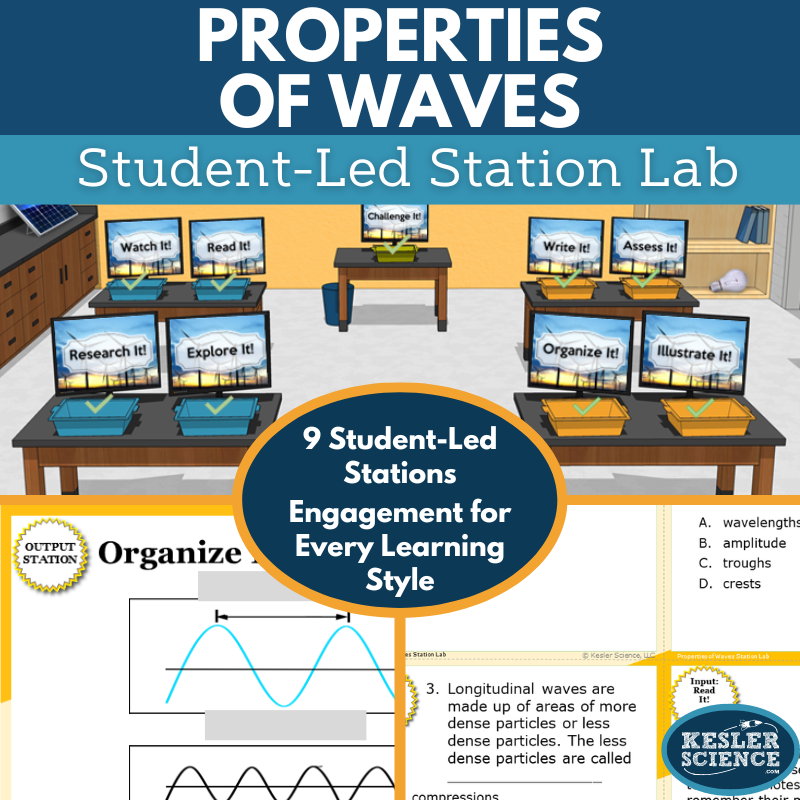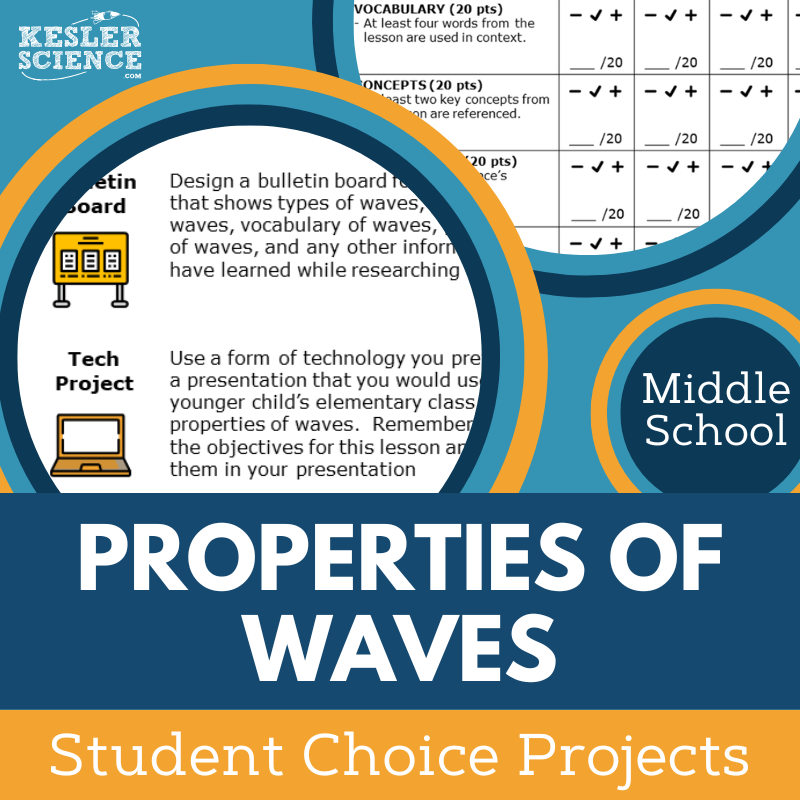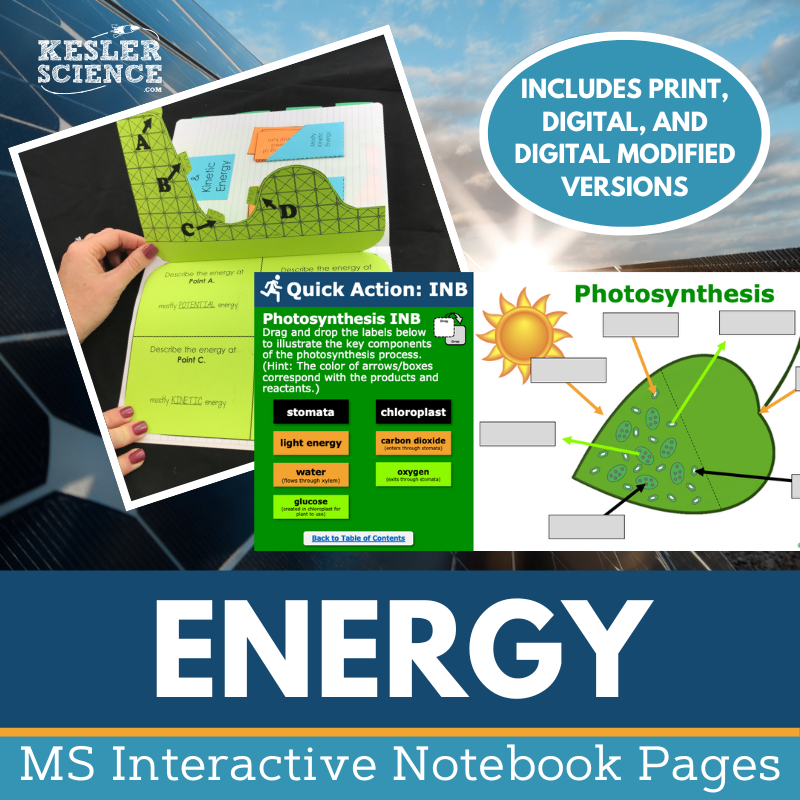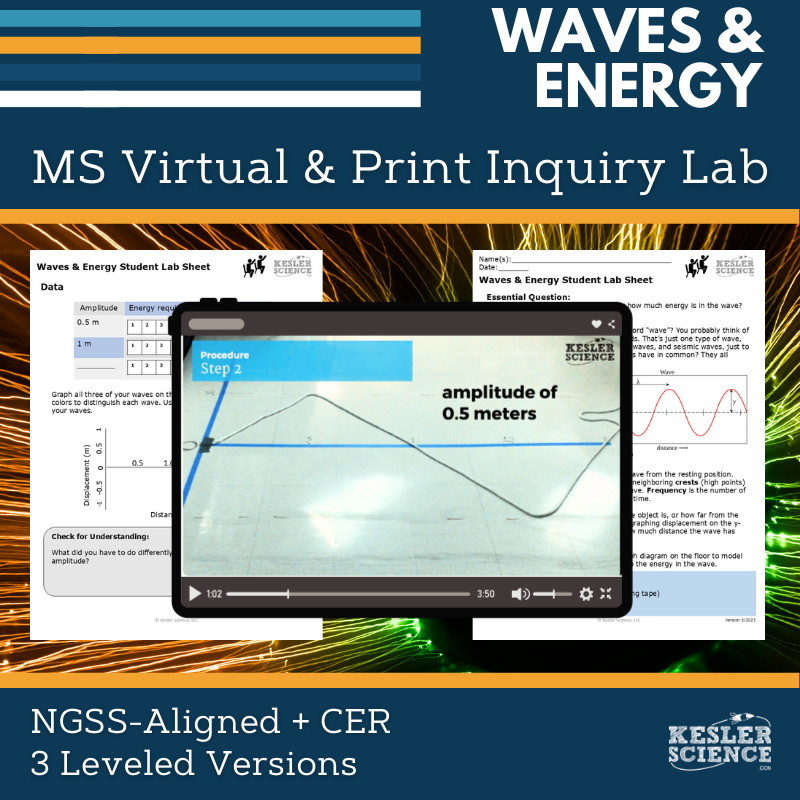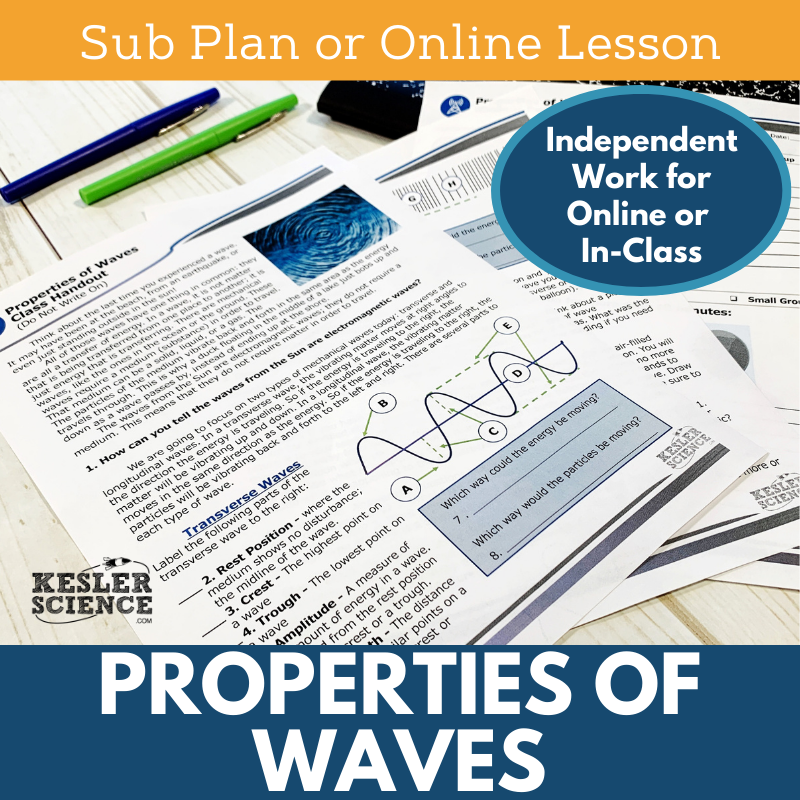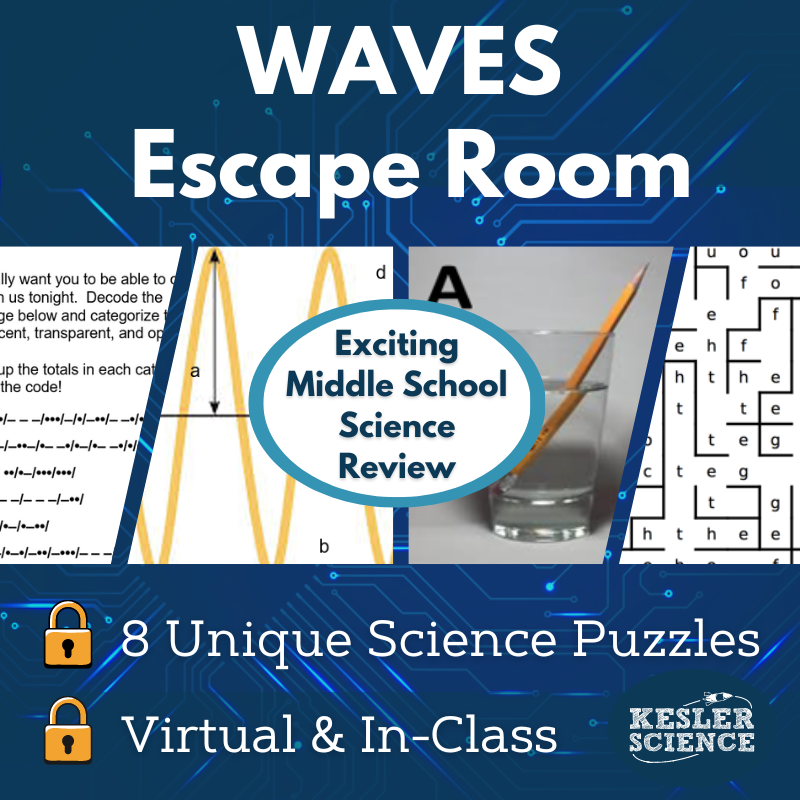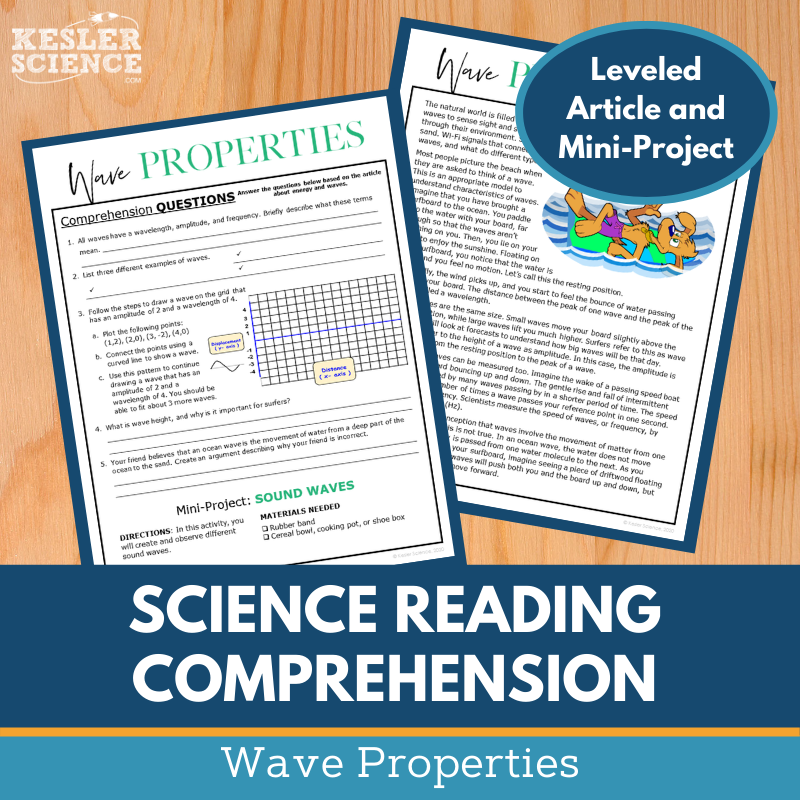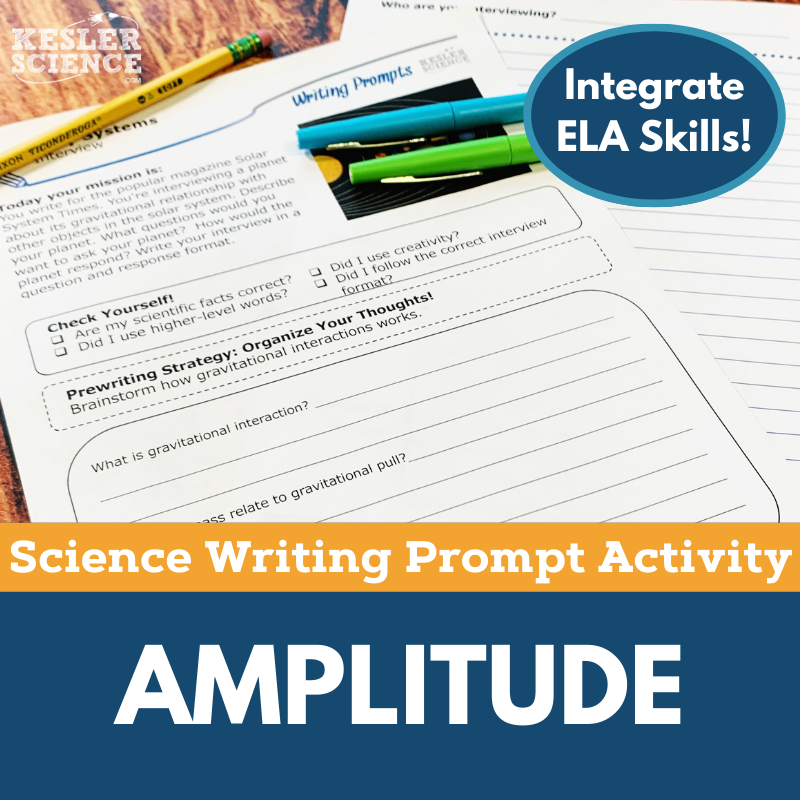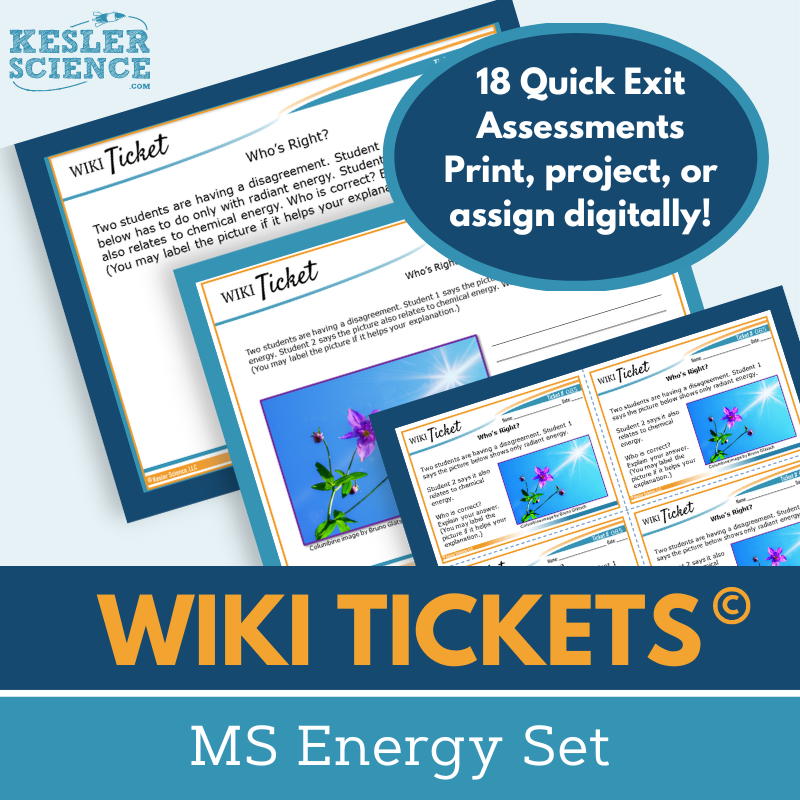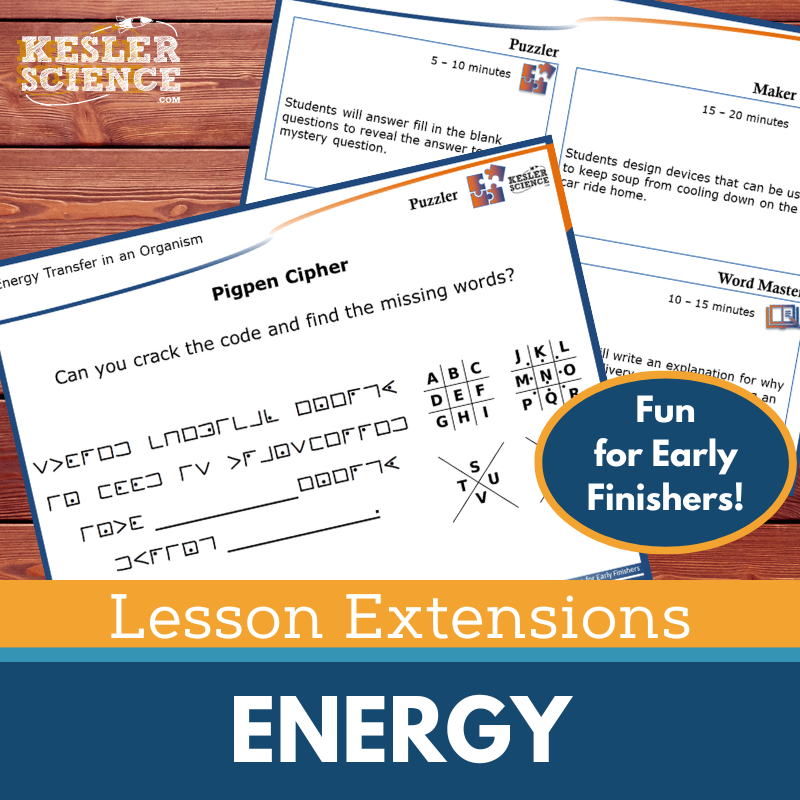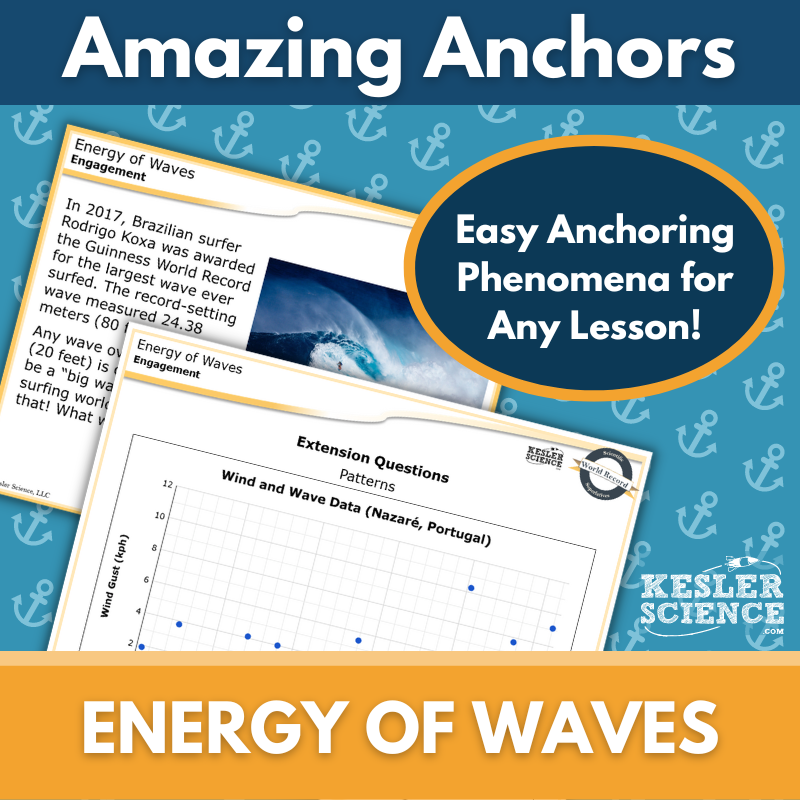Properties of Waves Activities for Middle School Science
The Kesler Science Properties of Waves resources provide a complete, student-centered lesson plan designed to engage middle school students in exploring the properties of waves. The resources below will give students a comprehensive understanding of the properties of waves. All of the following materials are also included in the Kesler Science Membership.
The Kesler Science Properties of Waves Complete 5E Lesson provides all the materials you need to teach a dynamic, multi-day lesson on wave properties with minimal prep. This student-led lesson helps junior high students answer essential questions about how matter and energy interact with waves, the three main types of mechanical waves, and wave properties.
Using the 5E model (Engagement, Exploration, Explanation, Elaboration, and Evaluation), the lesson features differentiated materials for various learning styles, multimodal activities, and maximum flexibility (printable, digital, and editable formats). It includes interactive stations, a variety of resources, and assessments to engage and challenge students.
Designed for both in-person and virtual classrooms, this lesson also offers Spanish translations, editable PowerPoints, and a mix of student choice projects and extension activities for deeper learning.
The Kesler Science Properties of Waves Complete 5E Lesson provides all the materials you need to teach a dynamic, multi-day lesson on wave properties with minimal prep. This student-led lesson helps junior high students answer essential questions about how matter and energy interact with waves, the three main types of mechanical waves, and wave properties.
Using the 5E model (Engagement, Exploration, Explanation, Elaboration, and Evaluation), the lesson features differentiated materials for various learning styles, multimodal activities, and maximum flexibility (printable, digital, and editable formats). It includes interactive stations, a variety of resources, and assessments to engage and challenge students.
Designed for both in-person and virtual classrooms, this lesson also offers Spanish translations, editable PowerPoints, and a mix of student choice projects and extension activities for deeper learning.
The Kesler Science Properties of Waves Station Lab offers a modular, student-led approach that will keep middle school students engaged while learning about wave properties. These comprehensive materials save prep time and allow students to direct their own learning by exploring wave reflection, absorption, and transmission through different materials.
With eight differentiated stations, plus a challenge station for early finishers, students will interact with multimodal resources like hands-on demonstrations, research tasks, readings, and videos. Teachers facilitate the learning process while students work independently or in small groups.
The lab can be adapted for both in-person and virtual learning environments, providing flexibility and ensuring a personalized learning experience for every student.
The Kesler Science Properties of Waves Station Lab offers a modular, student-led approach that will keep middle school students engaged while learning about wave properties. These comprehensive materials save prep time and allow students to direct their own learning by exploring wave reflection, absorption, and transmission through different materials.
With eight differentiated stations, plus a challenge station for early finishers, students will interact with multimodal resources like hands-on demonstrations, research tasks, readings, and videos. Teachers facilitate the learning process while students work independently or in small groups.
The lab can be adapted for both in-person and virtual learning environments, providing flexibility and ensuring a personalized learning experience for every student.
The Kesler Science Property of Waves Student Choice Projects let middle school students select a project that matches their strengths. With six project options plus a “design your own” choice, students can showcase their learning in a creative way.
Teachers can modify the included rubric to fit their grading needs, and there are differentiated project pages to accommodate varying student needs. Projects use common classroom materials like paper and markers, with some options adaptable for digital completion.
The projects offer flexibility, allowing students to explore wave properties while demonstrating their understanding through personalized formats.
The Kesler Science Property of Waves Student Choice Projects let middle school students select a project that matches their strengths. With six project options plus a “design your own” choice, students can showcase their learning in a creative way.
Teachers can modify the included rubric to fit their grading needs, and there are differentiated project pages to accommodate varying student needs. Projects use common classroom materials like paper and markers, with some options adaptable for digital completion.
The projects offer flexibility, allowing students to explore wave properties while demonstrating their understanding through personalized formats.
The Kesler Science Energy Interactive Notebook Bundle offers an engaging way to teach energy concepts with both print and digital options. It’s perfect for traditional classrooms, 1:1 environments, or distance learning, providing flexibility for teachers and students alike.
Topics include conduction, convection, and radiation, energy transformations, renewable and nonrenewable resources, photosynthesis, potential and kinetic energy, and more. The digital version features a unique interactive notebook PowerPoint, compatibility with Google Slides, reflection pages, teacher answer keys, and a modified version for accommodations. The paper version includes blank templates, pre-filled templates for modified needs, and visual guides for assembly.
This bundle ensures students can actively participate in learning energy concepts while offering teachers versatile tools for instruction and assessment in any learning environment.
The Kesler Science Energy Interactive Notebook Bundle offers an engaging way to teach energy concepts with both print and digital options. It’s perfect for traditional classrooms, 1:1 environments, or distance learning, providing flexibility for teachers and students alike.
Topics include conduction, convection, and radiation, energy transformations, renewable and nonrenewable resources, photosynthesis, potential and kinetic energy, and more. The digital version features a unique interactive notebook PowerPoint, compatibility with Google Slides, reflection pages, teacher answer keys, and a modified version for accommodations. The paper version includes blank templates, pre-filled templates for modified needs, and visual guides for assembly.
This bundle ensures students can actively participate in learning energy concepts while offering teachers versatile tools for instruction and assessment in any learning environment.
The Kesler Science Waves and Energy Inquiry Lab aligns with NGSS MS-PS4-1 and engages students in exploring how the amplitude of a wave is related to its energy. Students will construct a simple transverse wave model, measure amplitude, and analyze how changes affect the energy of the wave. Both digital and print formats include comprehension questions, C.E.R. prompts, and a reflection section to support student learning.
This lab is available in three differentiated versions—Modified, Dependent, and Independent—to support a range of learners. The Modified version offers sentence stems and multiple-choice questions, while the Dependent version blends instructions with inquiry-based tasks. The Independent version provides minimal guidance for a more student-led experience. A video demonstration is included in the digital version to support virtual learners or students without access to materials.
Hands-on materials include nylon rope, masking tape, dry erase markers, and a device to capture digital photos. The digital version requires no materials, offering interactive experiences directly in the file. All versions are editable and compatible with Google Slides, and teacher resources such as answer keys, setup guidance, and differentiated files are provided for easy planning and implementation.
The Kesler Science Waves and Energy Inquiry Lab aligns with NGSS MS-PS4-1 and engages students in exploring how the amplitude of a wave is related to its energy. Students will construct a simple transverse wave model, measure amplitude, and analyze how changes affect the energy of the wave. Both digital and print formats include comprehension questions, C.E.R. prompts, and a reflection section to support student learning.
This lab is available in three differentiated versions—Modified, Dependent, and Independent—to support a range of learners. The Modified version offers sentence stems and multiple-choice questions, while the Dependent version blends instructions with inquiry-based tasks. The Independent version provides minimal guidance for a more student-led experience. A video demonstration is included in the digital version to support virtual learners or students without access to materials.
Hands-on materials include nylon rope, masking tape, dry erase markers, and a device to capture digital photos. The digital version requires no materials, offering interactive experiences directly in the file. All versions are editable and compatible with Google Slides, and teacher resources such as answer keys, setup guidance, and differentiated files are provided for easy planning and implementation.
The Kesler Science Properties of Waves Sub Plan offers a comprehensive, student-centered lesson on wave properties. Students begin with a warm-up puzzle, followed by a reading passage and an activity where they analyze transverse and longitudinal waves. They then draw waves based on a scenario and finish with an assessment or exit ticket.
Extension activities allow early finishers to experiment with balloons or create different wave drawings. The lesson includes clear instructions for substitutes and a Google Form for distance learning, making it adaptable for both in-person and virtual classrooms.
Designed for maximum flexibility, the sub plans come with answer keys, editable documents, behavior checkpoints, and a class set of handouts. These lessons are great for substitute teachers, remote learning, and diverse classroom needs.
The Kesler Science Properties of Waves Sub Plan offers a comprehensive, student-centered lesson on wave properties. Students begin with a warm-up puzzle, followed by a reading passage and an activity where they analyze transverse and longitudinal waves. They then draw waves based on a scenario and finish with an assessment or exit ticket.
Extension activities allow early finishers to experiment with balloons or create different wave drawings. The lesson includes clear instructions for substitutes and a Google Form for distance learning, making it adaptable for both in-person and virtual classrooms.
Designed for maximum flexibility, the sub plans come with answer keys, editable documents, behavior checkpoints, and a class set of handouts. These lessons are great for substitute teachers, remote learning, and diverse classroom needs.
The Kesler Science Properties of Waves Escape Room lets students demonstrate their understanding of light and sound waves in an engaging, hands-on way. Teachers have full control over the puzzles, allowing flexibility for class duration. With eight puzzles to choose from, each is independent, so you can mix and match to fit your lesson.
You can run the escape room with minimal setup using manila envelopes, or create a more authentic experience with locks and a storage box. All necessary materials, including teacher directions and printable props, are included. Digital options for students are available through PowerPoint or Google Slides, making it easy for in-person or remote learning.
The product includes everything from detailed answer keys and a video challenge to editable templates and a Google Form answer sheet. Plus, there's a list of over 50 prize ideas to keep students motivated and engaged throughout the activity.
The Kesler Science Properties of Waves Escape Room lets students demonstrate their understanding of light and sound waves in an engaging, hands-on way. Teachers have full control over the puzzles, allowing flexibility for class duration. With eight puzzles to choose from, each is independent, so you can mix and match to fit your lesson.
You can run the escape room with minimal setup using manila envelopes, or create a more authentic experience with locks and a storage box. All necessary materials, including teacher directions and printable props, are included. Digital options for students are available through PowerPoint or Google Slides, making it easy for in-person or remote learning.
The product includes everything from detailed answer keys and a video challenge to editable templates and a Google Form answer sheet. Plus, there's a list of over 50 prize ideas to keep students motivated and engaged throughout the activity.
The Kesler Science Properties of Waves Reading Comprehension activity introduces middle school students to the relationship between wave amplitude and energy. Students read a nonfiction article, answer comprehension questions, and explore sound waves through a hands-on mini-project.
This resource is designed to enhance both science literacy and reading comprehension for grades 6-8, with leveled articles ranging from Lexile 1100-1300. The passage comes with interactive elements and a Cornell notes template to help students better grasp key concepts.
Perfect for in-person or virtual learning, this activity supports distance learning with editable PowerPoints for LMS platforms like Google Classroom. It’s great for assessments, extra credit, or building science literacy in the classroom or at home.
The Kesler Science Properties of Waves Reading Comprehension activity introduces middle school students to the relationship between wave amplitude and energy. Students read a nonfiction article, answer comprehension questions, and explore sound waves through a hands-on mini-project.
This resource is designed to enhance both science literacy and reading comprehension for grades 6-8, with leveled articles ranging from Lexile 1100-1300. The passage comes with interactive elements and a Cornell notes template to help students better grasp key concepts.
Perfect for in-person or virtual learning, this activity supports distance learning with editable PowerPoints for LMS platforms like Google Classroom. It’s great for assessments, extra credit, or building science literacy in the classroom or at home.
The Amplitude Science Writing Activity engages middle school students in an imaginative, songwriting-themed exercise to deepen their understanding of wave properties. This low-prep, student-centered prompt allows learners to creatively explore how amplitude relates to wave energy while building their writing and science reasoning skills. It supports both in-person and virtual learning environments, making it ideal for flexible classroom use.
This resource includes teacher directions with rubrics and project ideas, full- and half-sheet handouts for print use, and a digital PowerPoint version compatible with Google Slides. Students benefit from structured pre-writing tools, self-checks, and layout templates to guide their work. Whether displayed on a bulletin board or collected into student anthologies, the finished pieces showcase science literacy in a creative format.
Versatile in its application, the Amplitude prompt works well as a cross-curricular activity, pre-test assessment, student choice project, or enrichment for early finishers. It’s also effective for extra credit, make-up work, TELPAS samples, or differentiation. This activity assumes students have some prior content knowledge or research access to complete the task meaningfully.
The Amplitude Science Writing Activity engages middle school students in an imaginative, songwriting-themed exercise to deepen their understanding of wave properties. This low-prep, student-centered prompt allows learners to creatively explore how amplitude relates to wave energy while building their writing and science reasoning skills. It supports both in-person and virtual learning environments, making it ideal for flexible classroom use.
This resource includes teacher directions with rubrics and project ideas, full- and half-sheet handouts for print use, and a digital PowerPoint version compatible with Google Slides. Students benefit from structured pre-writing tools, self-checks, and layout templates to guide their work. Whether displayed on a bulletin board or collected into student anthologies, the finished pieces showcase science literacy in a creative format.
Versatile in its application, the Amplitude prompt works well as a cross-curricular activity, pre-test assessment, student choice project, or enrichment for early finishers. It’s also effective for extra credit, make-up work, TELPAS samples, or differentiation. This activity assumes students have some prior content knowledge or research access to complete the task meaningfully.
The Kesler Science Energy WIKI Tickets provide flexible, formative assessments for 6th-8th grade science topics in a fun and engaging format. This set includes 18 assessments, each aligned to NGSS and TEKS standards, covering topics like energy transformations, thermal energy transfer, wave characteristics, and more. WIKI Tickets can be used in various formats, including projection, printable handouts, and interactive digital versions for virtual or in-person learning.
Each topic offers five formats: full-screen projection, full-, half-, and quarter-page handouts, and editable PPT or Google Slides files for digital use. A bonus table of contents aligns each ticket to specific standards, ensuring comprehensive coverage. These assessments are perfect for exit tickets, bellringers, or gauging student understanding throughout a lesson.
"WIKI" stands for "What I Know Is," emphasizing student reflection and learning. Whether used in a traditional classroom or remote setting, these colorful and versatile assessments help you monitor progress effectively while keeping students engaged.
The Kesler Science Energy WIKI Tickets provide flexible, formative assessments for 6th-8th grade science topics in a fun and engaging format. This set includes 18 assessments, each aligned to NGSS and TEKS standards, covering topics like energy transformations, thermal energy transfer, wave characteristics, and more. WIKI Tickets can be used in various formats, including projection, printable handouts, and interactive digital versions for virtual or in-person learning.
Each topic offers five formats: full-screen projection, full-, half-, and quarter-page handouts, and editable PPT or Google Slides files for digital use. A bonus table of contents aligns each ticket to specific standards, ensuring comprehensive coverage. These assessments are perfect for exit tickets, bellringers, or gauging student understanding throughout a lesson.
"WIKI" stands for "What I Know Is," emphasizing student reflection and learning. Whether used in a traditional classroom or remote setting, these colorful and versatile assessments help you monitor progress effectively while keeping students engaged.
The Kesler Science Energy Lesson Extensions provide engaging, student-choice activities designed for early finishers or as a wrap-up to energy lessons. These extensions offer rigorous, fun opportunities for critical thinking and creativity while aligning with NGSS and TEKS energy standards.
Each Lesson Extension includes four activities: Puzzler for problem-solving, Maker Space for hands-on STEAM projects, Tech Connection for digital media integration, and Word Master for creative writing. Resources include teacher directions, answer keys, digital projection versions, and printable handouts.
Topics covered range from kinetic and potential energy to photosynthesis, thermal energy, and more. These versatile activities scaffold learning and engage students in deeper exploration of energy concepts, making them perfect for independent learners and classroom enrichment.
The Kesler Science Energy Lesson Extensions provide engaging, student-choice activities designed for early finishers or as a wrap-up to energy lessons. These extensions offer rigorous, fun opportunities for critical thinking and creativity while aligning with NGSS and TEKS energy standards.
Each Lesson Extension includes four activities: Puzzler for problem-solving, Maker Space for hands-on STEAM projects, Tech Connection for digital media integration, and Word Master for creative writing. Resources include teacher directions, answer keys, digital projection versions, and printable handouts.
Topics covered range from kinetic and potential energy to photosynthesis, thermal energy, and more. These versatile activities scaffold learning and engage students in deeper exploration of energy concepts, making them perfect for independent learners and classroom enrichment.
This Amazing Anchors Phenomenon Lesson introduces and reinforces the energy of waves through a real-world example of a surfer in Brazil. Students begin with an introductory reading that builds background knowledge and includes comprehension and extension questions to spark curiosity and prepare them for deeper learning.
The second part of the lesson features an explanatory reading that breaks down the science behind the energy of waves. Comprehension and reinforcement questions support student understanding, and the lesson is designed to serve as both an engagement and elaboration activity within the 5E instructional model.
This no-prep resource includes teacher directions, answer keys, projection slides, and both print and digital formats for flexible classroom or virtual use. Differentiated materials are provided, including a modified version with language supports and sentence starters to assist all learners.
This Amazing Anchors Phenomenon Lesson introduces and reinforces the energy of waves through a real-world example of a surfer in Brazil. Students begin with an introductory reading that builds background knowledge and includes comprehension and extension questions to spark curiosity and prepare them for deeper learning.
The second part of the lesson features an explanatory reading that breaks down the science behind the energy of waves. Comprehension and reinforcement questions support student understanding, and the lesson is designed to serve as both an engagement and elaboration activity within the 5E instructional model.
This no-prep resource includes teacher directions, answer keys, projection slides, and both print and digital formats for flexible classroom or virtual use. Differentiated materials are provided, including a modified version with language supports and sentence starters to assist all learners.
Year-Round Resources
These year-round activities will increase your students' understanding of many middle school science topics. All of these activities are also included in the Kesler Science Membership.
Visual Data & Graphing
You're not alone if your students struggle with understanding graphs, charts, and tables. It's a skill that takes an enormous amount of practice. This resource will help students build a strong foundation in analyzing data and creating their own data visualizations.
Bell Ringers and Warm-Ups
These middle school science bell ringers are an excellent way to engage your students as soon as they walk into your classroom. This comprehensive FULL YEAR resource includes everything you need to start off each science class with an interesting warm-up activity.
Review Board Games
Each game board has been carefully designed to keep students engaged. There are 10 different action spaces on each board and dozens of question cards. All of the actions are related to science concepts and keep the students motivated throughout the game.
Each game is ready to play. Simply print out the board and the cards and let the students enjoy reviewing nine different units.
Essential Questions
Below are the essential questions associated with the lessons and activities included in this unit. This topic is only one of more than 100 middle school science topics included in the Kesler Science Membership.
-
How do matter and energy interact when waves are generated?
-
What are the three main types of mechanical waves?
-
What are properties of waves?
Kesler Science Membership
Imagine never having to search for another middle school science lesson again. The membership gives you access to ALL of the Kesler Science products in one place (Yes, including everything above).
Say goodbye to long hours of lesson prep.

